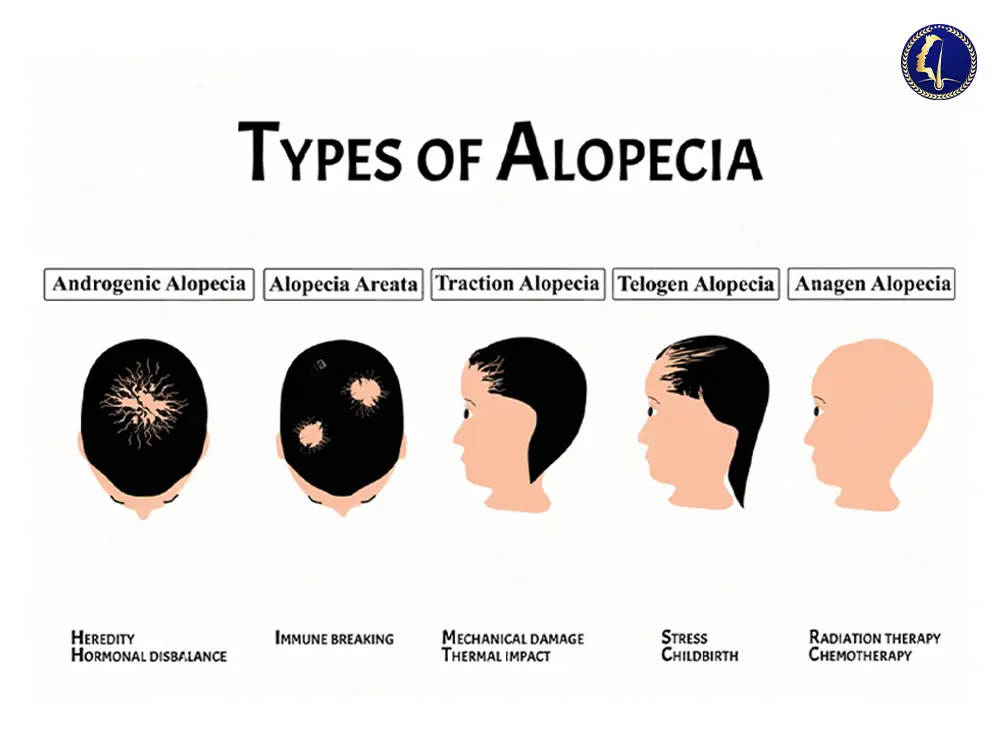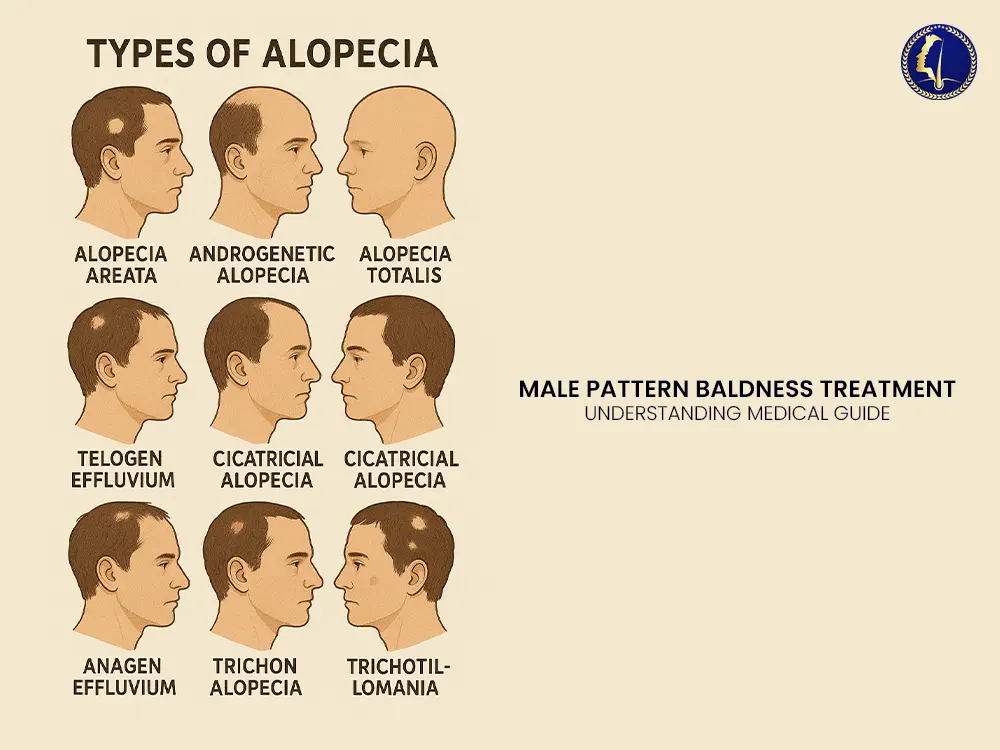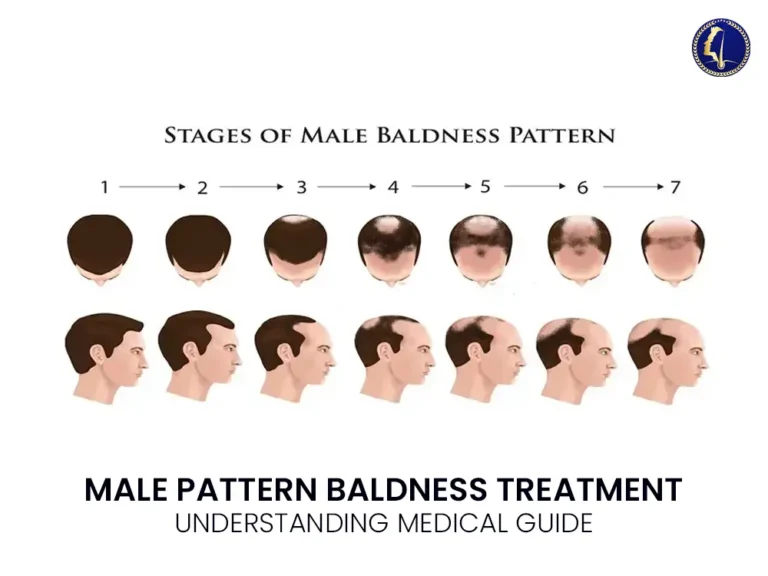Understanding Male Pattern Baldness (Androgenetic Alopecia)
Male pattern baldness—also known as androgenetic alopecia—is the most common type of hair loss among men, affecting over 50% of males by the age of 50. Characterized by a receding hairline, thinning crown, and eventual hair loss on the top of the scalp, it is a progressive condition with genetic and hormonal underpinnings.
In this blog, we’ll explore the causes, clinical progression, and evidence-based treatment options for male pattern baldness, including pharmaceutical, procedural, and lifestyle interventions. Our goal is to provide a reliable, medically sound overview rooted in current clinical best practices.
Main Causes of Male Pattern Baldness: Genetics, DHT & Hormonal Factors

Male pattern baldness is primarily caused by a genetic sensitivity to dihydrotestosterone (DHT), a byproduct of testosterone. Hair follicles on the scalp, particularly around the temples and crown, shrink under the influence of DHT—a process known as follicular miniaturization. Over time, affected follicles produce thinner, shorter hairs until they stop producing hair altogether.
Contributing Factors:
Genetics: Family history is the strongest predictor.
Hormonal changes: Elevated DHT levels trigger follicle miniaturization.
Age: The likelihood increases with age, especially after 40.
Stress and nutrition: While not primary causes, these can exacerbate hair loss.
Signs and Stages: Male Pattern Baldness Progression (Norwood Scale)

Diagnosis is usually clinical, based on history and physical examination. The Norwood-Hamilton scale is commonly used to classify stages of baldness, ranging from minimal hairline recession (Stage I) to severe vertex and frontal hair loss (Stage VII).
Diagnostic Tools:
Dermatoscopy: To inspect scalp follicular health.
Scalp biopsy: In uncertain or atypical cases.
Hormonal panels: If hair loss presents atypically or rapidly.
Best Male Pattern Baldness Treatments in Malaysia
Treatment strategies focus on slowing hair loss, stimulating regrowth, and restoring density. The most effective approaches often combine pharmaceutical therapy with procedural options.
1. Pharmacological & FDA-Approved Medications
a. Minoxidil (Topical)
Mechanism: Vasodilator that increases blood flow to hair follicles.
Formulation: 2% or 5% solution or foam.
Usage: Twice daily; long-term use is required.
Effectiveness: Visible results typically within 3-6 months.
FDA approved.
b. Finasteride (Oral)
Mechanism: Inhibits 5-alpha reductase, reducing DHT levels.
Dosage: Typically 1 mg daily.
Effectiveness: Slows progression in ~90% of users; regrowth in ~60%.
FDA approved.
Side effects: Decreased libido, erectile dysfunction (in a small percentage).
2. Procedural Hair Restoration Options
a. Platelet-Rich Plasma (PRP) Therapy
Mechanism: Uses patient’s own platelets to stimulate follicular activity.
Procedure: Blood is centrifuged, platelets extracted and injected into the scalp.
Evidence: Promising in early-stage baldness, though results vary.
b. Hair Transplant Surgery
Techniques: FUT (Follicular Unit Transplantation) or FUE (Follicular Unit Extraction).
Effectiveness: Permanent, natural-looking results.
Ideal candidates: Men with stabilized hair loss and adequate donor hair.
3. Adjunctive Therapies
Low-Level Laser Therapy (LLLT): May stimulate follicular function.
Nutritional supplements: Biotin, iron, and vitamin D if deficiencies exist.
Ketoconazole shampoo: Has mild anti-androgenic properties.
Preventing and Slowing Male Pattern Baldness

While genetics are non-modifiable, certain lifestyle adjustments may optimize scalp health and potentially delay progression:
Reduce stress: Chronic stress raises cortisol, possibly aggravating hair loss.
Anti-inflammatory diet: Rich in omega-3s, antioxidants, and lean protein.
Scalp hygiene: Prevents buildup that may clog follicles.
Avoid harsh treatments: Minimize heat styling, bleaching, and tight hairstyles.
Conclusion
Male pattern baldness is a chronic but manageable condition. The key to effective treatment is early intervention, consistent adherence to therapy, and consultation with a board-certified dermatologist or hair restoration specialist.
A personalized, evidence-based approach combining medication, procedures, and lifestyle management offers the best results.
FAQs
1. Can Male Pattern Baldness Be Reversed?
While complete reversal is rare, early treatment can slow or halt progression and in some cases, promote regrowth. Advanced cases may benefit from hair transplantation.
2. Is Finasteride Safe for Long-Term Use?
Yes, clinical studies support its long-term safety for most users, though some report sexual side effects. Regular monitoring by a physician is recommended.
3. Does Stress Cause Hair Loss?
Stress alone doesn’t cause male pattern baldness but may accelerate the process. Telogen effluvium, another type of hair loss, is directly stress-related.
4. How Long Until Minoxidil Shows Results?
Typically 3 to 6 months of consistent use are needed to notice visible improvement. Initial shedding may occur but is usually temporary.
5. Do Natural Remedies Work for Hair Loss?
There’s limited scientific evidence supporting natural remedies. While some may improve scalp health, they are not substitutes for clinically proven treatments like minoxidil or finasteride.
Expert Hair Loss Treatment Insights from GLOJAS Plastic Surgery Specialist Clinic
Male pattern baldness treatment, also known as androgenetic alopecia, remains the most common cause of hair loss in men — but it’s also one of the most treatable when addressed early. The most effective hair loss treatment for men often involves combination therapy, such as topical or oral minoxidil paired with finasteride or dutasteride, both of which are FDA-approved 5-alpha-reductase inhibitors (5-ARIs) that reduce DHT levels. Some patients benefit from adding ketoconazole shampoo or natural DHT blockers like saw palmetto and pumpkin seed oil for a gentler boost. For those seeking alternatives, oral minoxidil (off-label) and microneedling with minoxidil or finasteride are showing impressive results in clinical studies.
Beyond medication, procedural and device-based options are redefining hair restoration for men. PRP (Platelet-Rich Plasma) therapy stimulates dormant follicles using your own growth factors, while microneedling enhances topical treatment absorption for thicker regrowth. Advanced hair transplant techniques like FUE or FUT deliver permanent, natural-looking results for men with stabilized hair loss. For non-surgical enhancement, LLLT (Low-Level Laser Therapy) helmets, caps, and combs — whether using laser diodes or LED light devices — can improve scalp circulation and follicle activity. Experimental approaches such as Redensyl, Botox scalp injections, and emerging hair cloning and stem cell therapy represent exciting frontiers for the future.
A holistic approach also addresses the emotional and lifestyle aspects of baldness. Many men experience anxiety, self-esteem issues, and even social media–driven body image pressure due to hair loss. Incorporating stress reduction, an anti-inflammatory diet rich in omega-3s and antioxidants, and avoiding harsh styling practices like heat, bleaching, or tight hairstyles can help preserve existing hair. While natural remedies such as rosemary oil, caffeine shampoo, and black seed oil may support scalp health, they should complement — not replace — clinically proven solutions. Whether your goal is to slow shedding, regrow hair, or achieve a complete hair restoration, the key is starting early, personalizing your treatment plan, and working with a qualified hair loss specialist to find the best treatment for baldness that suits your needs.
